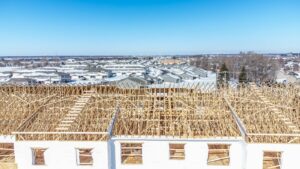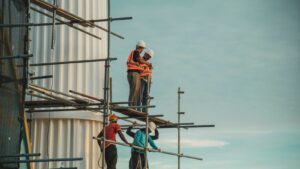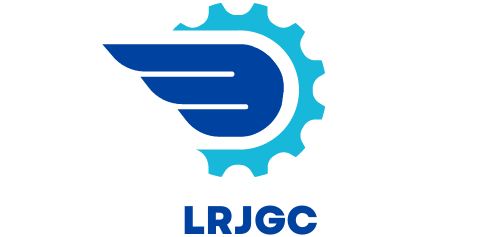Multifamily construction is evolving rapidly, driven by changing demographics, technological advancements, and shifting lifestyle preferences. Urbanization and the desire for more sustainable living environments are pushing developers to rethink traditional approaches. From smart home technologies to eco-friendly building materials, the latest multifamily construction trends are reshaping how multifamily units are designed and constructed.
Developers and investors are paying close attention to these trends to stay competitive in a dynamic market. With an increasing focus on community amenities, energy efficiency, and flexible living spaces, multifamily construction trends are becoming more attractive to a diverse range of residents.
Multifamily Construction Trends
Green Building Materials
 Green building materials reduce the environmental impact of multifamily construction trends. Common materials include recycled steel, which offers strength and durability, and reclaimed wood, providing a rustic aesthetic. Low-VOC (Volatile Organic Compounds) paints improve indoor air quality. Bamboo flooring, both renewable and resilient, is gaining popularity. These materials not only lower carbon footprints but also appeal to eco-conscious residents.
Green building materials reduce the environmental impact of multifamily construction trends. Common materials include recycled steel, which offers strength and durability, and reclaimed wood, providing a rustic aesthetic. Low-VOC (Volatile Organic Compounds) paints improve indoor air quality. Bamboo flooring, both renewable and resilient, is gaining popularity. These materials not only lower carbon footprints but also appeal to eco-conscious residents.
Energy-Efficient Designs
Energy-efficient designs enhance the sustainability of multifamily buildings. Developers employ high-performance windows with low-E coatings to minimize heat loss. Insulated concrete forms (ICFs), used for walls and roofs, provide superior thermal performance. LED lighting systems consume less energy, reducing electricity bills. Solar panels, frequently installed on rooftops, contribute renewable energy, decreasing reliance on fossil fuels. Such designs improve energy efficiency and attract tenants seeking lower utility costs and environmental responsibility.
Technological Innovations
Smart Home Integrations
Smart home integrations transform multifamily construction trends by incorporating advanced systems like automated lighting, climate control, and security. These systems offer tenants convenience and energy efficiency. Properties with smart thermostats, keyless entry systems, and voice-activated assistants attract tech-savvy residents. Units equipped with smart appliances and IoT devices provide real-time data, allowing tenants to monitor and reduce energy consumption.
Construction Automation
Construction automation enhances efficiency and precision in multifamily projects. Technologies like Building Information Modeling (BIM), drones, and 3D printing streamline design and construction. BIM provides detailed 3D models that improve collaboration among project stakeholders, reducing errors. Drones assist in site surveys and progress monitoring, offering real-time data to make informed decisions. Meanwhile, 3D printing expedites the production of building components, lowering labor costs and material waste.
Changes in Design Preferences
Design multifamily construction trends are rapidly evolving due to shifting demographics and urbanization. Developers focus on modern aesthetics, functionality, and sustainability to meet the diverse needs of residents.
Mixed-Use Spaces
 Multifamily construction increasingly incorporates mixed-use developments, integrating residential, commercial, and recreational areas within the same building. This multifamily construction trend caters to urban dwellers seeking convenience, reducing the need for long commutes. Projects often feature ground-floor retail, office spaces, and amenities such as gyms and cafes. For example, New York and Los Angeles see a surge in developments that combine apartments with coworking spaces, appealing to professionals and remote workers.
Multifamily construction increasingly incorporates mixed-use developments, integrating residential, commercial, and recreational areas within the same building. This multifamily construction trend caters to urban dwellers seeking convenience, reducing the need for long commutes. Projects often feature ground-floor retail, office spaces, and amenities such as gyms and cafes. For example, New York and Los Angeles see a surge in developments that combine apartments with coworking spaces, appealing to professionals and remote workers.
Compact Living Solutions
Compact living solutions are gaining popularity due to rising urban real estate costs. Developers design smaller, efficient apartments maximizing space through innovative layouts and multifunctional furniture. These units often include smart storage solutions, wall beds, and convertible spaces to enhance livability. For instance, micro-apartments in cities like San Francisco and Tokyo offer stylish yet practical living conditions, meeting the demands of single professionals and young couples.
Economic and Market Factors
Economic and market factors significantly influence multifamily construction trends. These elements shape project feasibility, impact financing, and determine the demand for various housing types.
Market Demand and Demographics
 Market demand and demographics drive the type and location of multifamily projects. Urbanization trends and employment opportunities in metropolitan areas increase demand for housing in cities. Millennials and Gen Z seek urban living with amenities and proximity to work, fueling the growth of mixed-use developments. Elderly populations’ preferences for accessible, community-centric housing shape senior living projects. Diverse demographic needs push developers to offer a range of unit types, from micro-apartments to family-sized units, ensuring broad appeal.
Market demand and demographics drive the type and location of multifamily projects. Urbanization trends and employment opportunities in metropolitan areas increase demand for housing in cities. Millennials and Gen Z seek urban living with amenities and proximity to work, fueling the growth of mixed-use developments. Elderly populations’ preferences for accessible, community-centric housing shape senior living projects. Diverse demographic needs push developers to offer a range of unit types, from micro-apartments to family-sized units, ensuring broad appeal.
Embracing New Technology
Multifamily construction trends are evolving rapidly, driven by urbanization, sustainability, and technological advancements. Developers are embracing eco-friendly materials, smart technologies, and community-oriented amenities to meet the diverse needs of modern residents. Mixed-use projects and flexible living spaces cater to the preferences of millennials, Gen Z, and remote workers.

